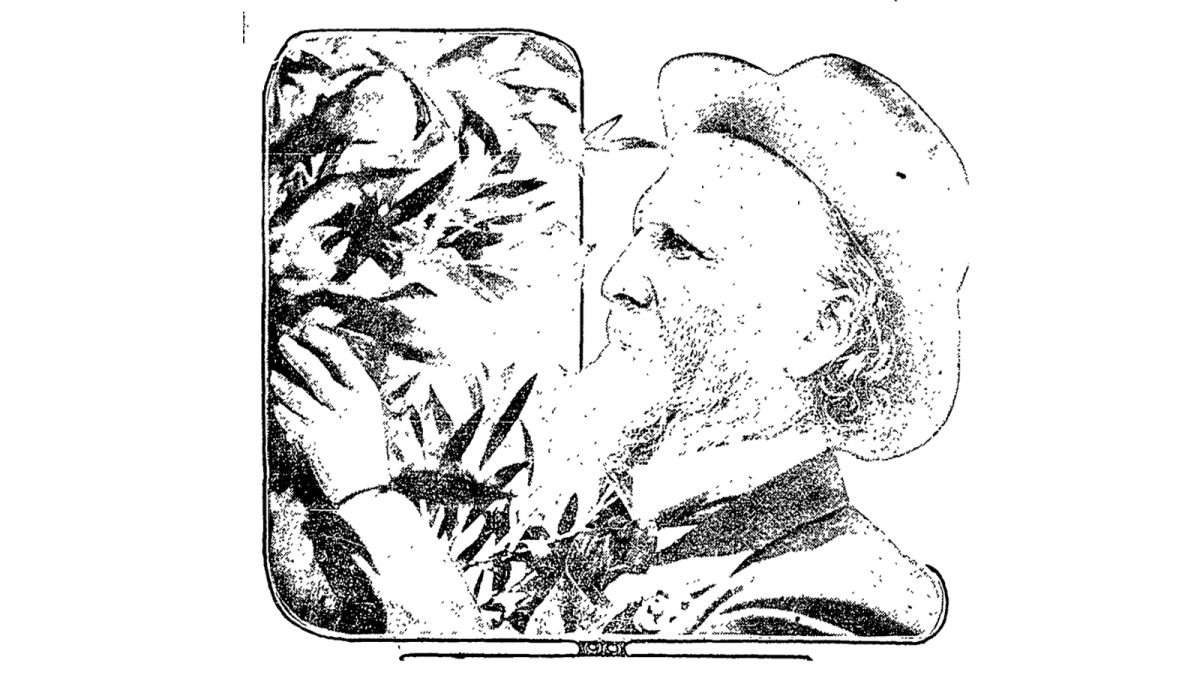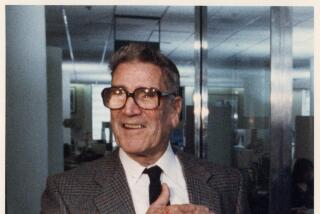From the Archives: Earth He Loved Reclaims Him. John Muir, Apostle of the Wild is Dead.

- Share via
John Muir is dead.
Up through the far-flung reaches of the Yosemite, the Sequoia, the Muir Woods and all the mountain wilds of the West will ring the mournful echo of that message, for the birds and the beasts and all living things have lost a friend.
America has lost perhaps its greatest naturalist, the world one of its most remarkable nature poets.
John Muir died of double pneumonia at the California Hospital yesterday morning and until his death released the great soul few even knew that he was in Southern California.
Possessing a wonderful fund of information gathered during all the years of his wanderings among the wilds of the world, Mr. Muir was a slow producer; yet the books and stories he has written stand out in bold relief on the best bookshelves of the world. It was while he was polishing and repolishing his book on Alaska at his home in Martinez, that the strain and overwork reduced his vitality. He laid aside the pen and left for Daggett, where his daughter, Mrs. Buel A. Funk, resides, in the hope that a change of air would bring relief.
Dr. McKenzie of Daggett sent for Dr. George L. Cole of Los Angeles, last Monday. Dr. Cole pronounced it a case of double pneumonia, but felt that the great naturalist was in condition to be moved. Wednesday night he was taken aboard a train and sent here, arriving shortly after midnight, where an ambulance met him and took him to the California Hospital. His condition seemed improved early yesterday morning, but at 10 o’clock it grew worse and twenty minutes later he was dead.
The body was removed to the Brown mortuary chapel and will be taken to the Muir ranch in Contra Costa county near Martinez today and the funeral will probably be held on Sunday. Mr. and Mrs. Funk will accompany the body north. Another daughter, Mrs. T. R. Hanna, lives on a ranch adjoining that owned by her late father. He was married in 1880 to Louise Strentzel, who died ten years ago.
REMARKABLE MAN
John Muir was one of the most remarkable characters of all the remarkable men and women produced by contact with the primitive West. He was born in Scotland, April 21, 1838, and came to the United States when 11 years old. For eleven years he helped his father clear a farm near Fox River, Wis., and during that time earned enough money to go to college. He entered the University of Wisconsin at an age when the average student is finishing his course, and in 1864 he was graduated.
Mr. Muir was a man of peace. The call of nature took him to the unexplored regions of North America, where he obtained a practical experience that made him one of the greatest geologists and botanists of his time. While California was a struggling mining State, with prospects of never becoming anything else, John Muir was exploring the Yosemite Valley. He launched a campaign that conserved the natural wonders of the Yosemite and Sequoia parks by having them made national monuments.
He knew every landmark along the whole length of the Sierras, and from his lonely residence in the wilds he carried on research of animal life and vegetation. In later years the wonderful redwood forest overlooking San Francisco from an elevation across the bay, became known as the Muir Woods.
In 1879 John Muir went to Alaska and there discovered Glacier Bay. The Muir glacier, made famous by a painting by the late H. L. A. Culmer, was named for him.
A year later he led a relief expedition into the Arctics in search of the ill-fated DeLong party.
The great conservation movement which resulted in the establishment of national parks won its success through the personal efforts of John Muir. He wrote a book on “The Mountains of California” and another on “Our National Parks” as well as several volumes on nature work, study and research. His contributions to magazines and his papers read before scientific bodies brimmed with information that no other naturalist possessed.
ABLE WORKMAN
John Muir was painstaking in the production of his literary works and never produced a volume or story unless it was polished to a fine degree. He worked slowly, arduously and with tremendous success. He died with more knowledge and experience untold than he could have produced in another lifetime.
In later years the naturalist visited other parts of the world where he studied tree and plant life. He went into the jungles far up the Amazon, found the precious Baobab tree in South Africa, searched the vegetation of every continent for rare and peculiar growths, visited all the countries of the world that would interest a man of his kind and when he came home he said:
“I had a wonderful opportunity to study the three rare trees and plants I went in search of and saw many beautiful and strange things, but when it comes right down to beautiful and grand scenery, California leads the world.”
MEMORIAL SERVICE
The Christmas jollification of the members of Muir lodge of the southern branch of the Sierra Club, scheduled for Saturday night in Santa Anita Canyon has been changed to a memorial service in honor of the noted naturalist. The mountain lovers will meet as planned, but the jollification features around the large Christmas tree will be called off. Muir lodge was dedicated in November, 1913, in honor of Mr. Muir, the president of the Sierra Club.
___________________________
JOHN MUIR’S WORK. SOME NOTABLE ACHIEVEMENTS
[BY A. P. NIGHT WIRE]
SAN FRANCISCO, Dec. 24,—John Muir, like John Burroughs, with whom his name often has been linked, belonged to that tradition of British naturalists whose work was so fused with the writer’s personality and so penetrated by individual feeling that their output was as much literature as science.
Philosopher and artist, as well as observer, he took a creative delight in his work which no mere classification of details could have brought.
His descriptions of the Yosemite Valley first brought it into national fame, and his visit there left him with a love of the West which remained through all his travels and led him to make his home at Martinez in his later years. He chose a site in the Contra Costa Valley sheltered on one side by a wooded hill and surrounded on three others by vineyards, orchards and streams, confronted by the towering outline of Mt. Diablo. Within, the furnishings were in massive simplicity. Without was a riot of pines, palms, cacti and exotic vegetation, for botany, too, was one John Muir’s delights.
“But this isn’t my home,” he once said. “My home is in the mountains and the wilds. I am here merely for the rest my body demands. I am getting old and what once was exercise is now fatiguing exertion.”
With this deep love of nature part of his very being it was fitting that John Muir should be almost was well known for his labors in behalf of forest preservation and the establishment of national reserves and parks as by his writings.
His travels, partly in company with John Burroughs, took him to Honolulu, Russia, Siberia, Manchuria, India and Australasia, but this life work was in the mountains of Western America, where he made an elaborate classification of fauna and floral life, supplemented by much descriptive writing, both in book form and in the periodical press and the newspapers. As his work became more and more widely known, Harvard, Yale, Wisconsin and other universities granted him honorary degrees and he was elected to membership in many scientific societies. Of recent years his signature was more rarely seen, but he had remained sturdy and active until his sudden seizure by pneumonia.
The famous Muir redwood grove in Marin county, at the foot of Mt. Tamalpais, was named for the distinguished naturalist.
IN THE YOSEMITE
John Muir’s exploration of the Yosemite Valley was made in winter. With a companion, the naturalist plunged into the canyon on snowshoes, and the trip proved extremely perilous.
His sturdy build and splendid health enable Muir to perform “hikes” through the mountains that few athletes would have been able to accomplish. On those tours through the wilds of the high Sierra, he traveled exceedingly light. On some trips, lasting weeks, his only provisions would be tea, a few cakes of chocolate and a knapsack filled with bread crumbs.
Muir had a great love of the Yosemite and his was a familiar face to summer tourists there. He was a warm advocate of a movement to make the valley accessible to visitors who came to see the Yosemite’s grandeur, but he had no regard whatever for those who came to fish in the valley. He could not understand how any one could, even for the moment, neglect nature’s wonders for angling. He would refer to them as being “sillier than the silly fish themselves.”
INVENTIVE MIND
Muir as a lad on the farm had an inventive bent which might have rivaled that of Thomas A. Edison, had it not been discouraged by a stern parent. Among his achievements was an alarm clock device which dumped him out of bed at any desired time. This saved him the trouble of making up his mind to get up in a cold room, but he improved upon it by another clockwork system, which lighted the fire in the kitchen stove at any desired time and made it unnecessary to get up at all, for that purpose.
These and many other devices which he brought into use about the farm were disapproved by his father, who cited biblical passages against them.
More to Read
Start your day right
Sign up for Essential California for the L.A. Times biggest news, features and recommendations in your inbox six days a week.
You may occasionally receive promotional content from the Los Angeles Times.






